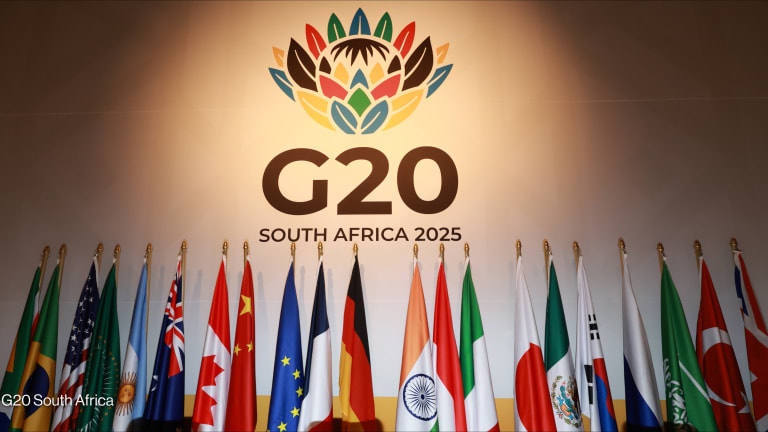World leaders 'missed opportunity' to relieve long-term debt burdens
As global leaders gathered last week for the IMF-World Bank Spring Meetings, debt was high on the agenda. But even as additional liquidity announcements were made, questions remain about debt restructuring.
The International Monetary Fund and World Bank Spring Meetings last week left at least one major question unanswered: Will global efforts go far enough to relieve unsustainable debt burdens? While many of the efforts to date have helped, they have largely targeted a liquidity shortfall rather than increasingly unsustainable debt levels, experts said. “There was a whole range of missed opportunities at the G-20 meeting,” said Nadia Daar, the head of Oxfam International’s Washington office. “They really failed to take any further ambitious action.” One of the disappointments was that there was little discussion about debt cancellation and the G-20 Common Framework for Debt Treatments, she said. Debt levels were rising pre-pandemic, but they have been exacerbated in the past year. In Africa, debt to gross domestic product ratio jumped from 42% in 2010 to 65% in 2020, according to Vera Songwe, executive secretary at the United Nations Economic Commission for Africa. Who holds that debt has also changed dramatically — from about 80% concessional multilateral debt a decade ago to about 30% today. About 40% of the continent’s debt comes from the private sector and 30% from new lenders, including China, she said. While the temporary debt relief has been “hugely welcome,” the debt burden for many countries will be “equally if not more difficult,” Daar said. “We really need to see cancellation as a priority.” “I fear not enough lessons were learned from earlier periods of debt … It’s very clear that for a large group of countries, debt servicing is compromising their ability to provide basic services for the most vulnerable citizens and children.” --— Kevin Watkins, CEO, Save the Children There were three big announcements related to debt last week. The G-20 said it would extend the G-20 Debt Service Suspension Initiative through the end of 2021, and it would be the final extension. Second, IMF said that it would provide the 28 lowest-income countries with continued debt relief, forgiving their debt payments through October. It specified that one last round of forgiveness would follow. Third, and perhaps most significantly, the G-20 and IMF took the next steps toward a new issuance of $650 billion in IMF Special Drawing Rights and discussed how a new allocation could be accompanied by a mechanism for higher-income countries to transfer SDRs to lower-income countries. While an SDR issuance is seen as critical, particularly for middle-income countries that have been left out of other debt relief efforts, experts told Devex it is not enough. Middle-income countries were left out of the formal conversations on debt restructuring at the G-20 last week. Despite the U.S. advocating for middle-income countries to be included in G-20 debt discussions, there doesn’t appear to be a consensus around expanding the programs, experts told Devex. That could be partly because China is reluctant to be part of further debt relief, which could be slowing that effort, said Eric LeCompte, executive director at Jubilee USA Network. Even as this crisis continues and questions about the Framework and debt restructuring process are unanswered, leaders also need to think about preventing the next crisis from happening, LeCompte said. If the world had implemented policies about public debt transparency and establish a global bankruptcy process — as has been previously discussed in global agreements — those tools would have helped in this crisis, he said. “I fear not enough lessons were learned from earlier periods of debt,” said Kevin Watkins, Save the Children CEO, at an event last week. “It’s very clear that for a large group of countries, debt servicing is compromising their ability to provide basic services for the most vulnerable citizens and children.” But civil society wasn’t alone in bemoaning the lack of prior action. “It is regrettable that when the world was simpler and debt problems involved a smaller cast of characters,” that IMF wasn’t able to push through a different approach to debt resolution, said Kristalina Georgieva, IMF managing director, at an event last week. This crisis could be an opportunity to do so, with the G-20 Common Framework the first chance to bring together a broader cast of creditors, she said. The IMF must move quickly and get all creditors engaged in the process, including new bilateral creditors and the private sector. If the early framework efforts succeed, they can set important precedents, Georgieva said. IMF and World Bank have a responsibility to push hard for transparency and ensure disclosure of often hidden debt, she added. A key to real progress in improving international debt architecture is getting support from those “without whom we cannot move,” Georgieva said regarding China and the private sector. Private bondholders may be willing to come to the table and even accept some losses when there is a high level of transparency, goodwill, and a willingness to make reforms, said Julie Monaco, managing director at Citigroup. Restructuring commercial bank debt is a different story. If commercial banks are forced to restructure debt, it will have a long-term impact on a country’s ability to get commercial credit, Monaco said at an event last week. The key in debt negotiations is to carefully balance the tradeoffs in the process and do it in a way that doesn’t cut the country off from private sector funding — which will be critical to financing the Sustainable Development Goals — in the future, she said. Mohamed El-Erian, the president of Queen’s College at Cambridge, is not as quick to believe that the private sector will jump to participate. Thus far, most of the action on debt has come from the official sector. That is unlikely to change without more of a “stick” approach, such as by compelling the private sector to engage rather than trying to incentivize it to do so. He said: “I don’t think the carrot works well enough. The incentive to free ride is enormous.”
The International Monetary Fund and World Bank Spring Meetings last week left at least one major question unanswered: Will global efforts go far enough to relieve unsustainable debt burdens?
While many of the efforts to date have helped, they have largely targeted a liquidity shortfall rather than increasingly unsustainable debt levels, experts said.
“There was a whole range of missed opportunities at the G-20 meeting,” said Nadia Daar, the head of Oxfam International’s Washington office. “They really failed to take any further ambitious action.”
This story is forDevex Promembers
Unlock this story now with a 15-day free trial of Devex Pro.
With a Devex Pro subscription you'll get access to deeper analysis and exclusive insights from our reporters and analysts.
Start my free trialRequest a group subscription Printing articles to share with others is a breach of our terms and conditions and copyright policy. Please use the sharing options on the left side of the article. Devex Pro members may share up to 10 articles per month using the Pro share tool ( ).
Adva Saldinger is a Senior Reporter at Devex where she covers development finance, as well as U.S. foreign aid policy. Adva explores the role the private sector and private capital play in development and authors the weekly Devex Invested newsletter bringing the latest news on the role of business and finance in addressing global challenges. A journalist with more than 10 years of experience, she has worked at several newspapers in the U.S. and lived in both Ghana and South Africa.








